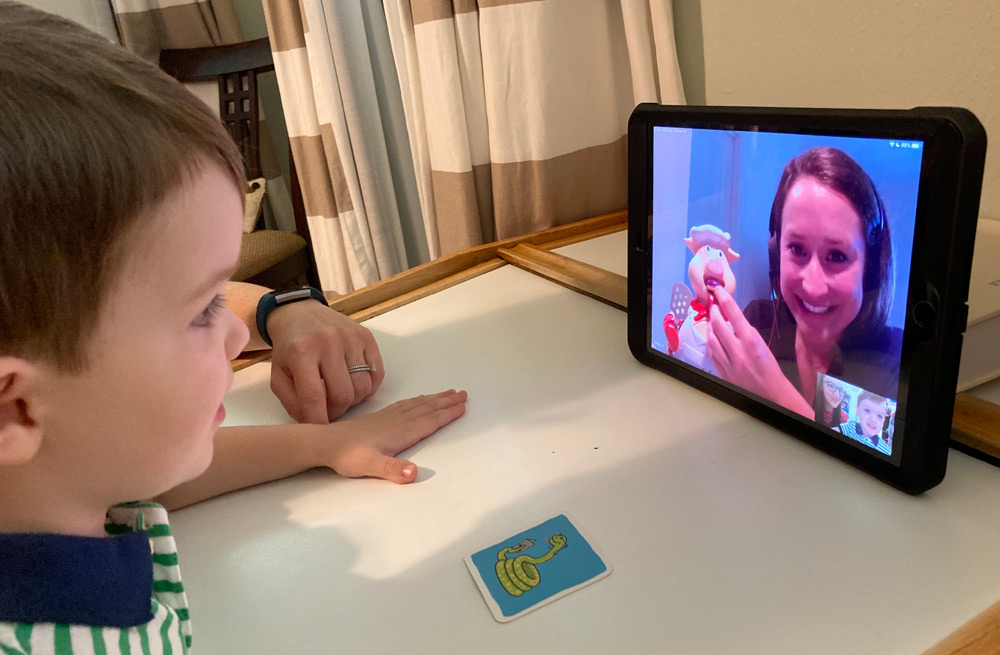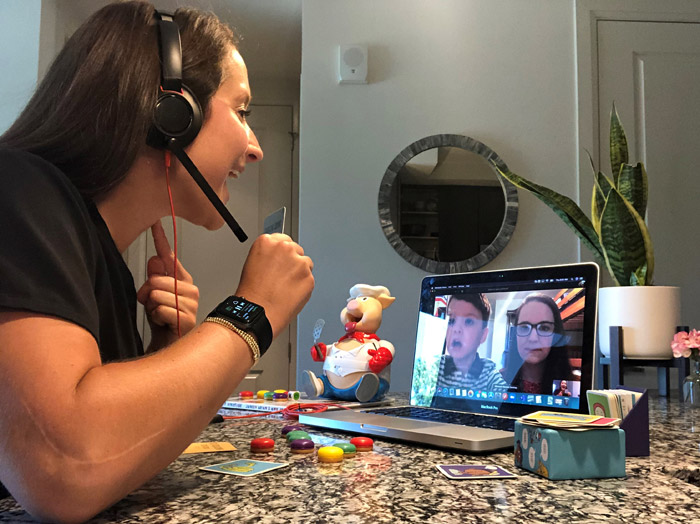
As The University of Texas at Dallas moved classes online this spring and closed most campus offices due to COVID-19, another decision had to be made about the University’s Callier Center for Communication Disorders — how to continue treating its 4,000 patients and how to facilitate the clinical experience needed by graduate students to complete their degrees.
The Callier Center is one of the University’s few centers where patients — both children and adults — are seen regularly. It also provides hands-on training for graduate students pursuing degrees in speech-language pathology and audiology through the School of Behavioral and Brain Sciences.
Dr. Andrea Gohmert, Callier director of audiology clinical operations, said the clinical team moved quickly to a telehealth model.
“We did about 10 years of work in 10 days,” she said. “We identified a safe platform, and we’re doing the best we can to provide every possible service that doesn’t involve actual contact with a patient.”
Security was the primary concern of the transition to online services; the system had to meet medical privacy standards. Because patient health records are stored at the Dallas Callier Center office, a system had to be arranged for clinical staff to access them securely.

By the first of April, the telehealth program was in full use, allowing most Callier patients access to audiologists, speech-language pathologists and clinical staff.
While diagnostic testing cannot be done remotely, audiology patients have received basic services, such as hearing-aid adjustments. For most hearing aids, the audiologist can use a phone app to make modifications by accessing the patient’s individual prescriptive programs remotely. Other patients are shown how to clean their hearing aids, or as a last resort, they can ship the device to one of the Callier audiologists for modifications.
“It’s still not ideal; face-to-face would be better. But I can’t tell you the angst a parent must feel. They may be home all day with a child who can’t hear, so they need that hearing aid working properly,” Gohmert said.
Callier’s speech-language pathologists also are working to meet the needs of families sheltering in their homes.
Melissa Sweeney, director of speech-language pathology clinical operations, said most therapy services have transferred well to the telehealth environment, although speech evaluations are more difficult to do on a video call because nuanced speech sounds are harder to hear. With a parent nearby to help, such problems can be overcome, she said.
“There are a number of situations with articulation therapy where we really have to hear fine details,” she said. “We need a parent to give us a little bit of information, helping us figure out whether or not the child said a particular word or sound.”
Besides offering clinical services, a major part of Callier’s role at UT Dallas is to provide hands-on clinical experiences to graduate students training to be audiologists and speech-language pathologists. A certain number of contact hours are required for licensing.
“We are so pleased to be able to continue our son’s therapy a couple times a week — picking up exactly where we left off. We have been impressed with all of the adaptations being made. It has been fabulous.”
Megan Wallace, whose 3-year-old son, Ben, is a speech patient at the Callier Center
According to Dr. Colleen Le Prell, area head of communication sciences and disorders and the Emilie and Phil Schepps Professor in Hearing Science, students have been able to earn clinical hours by joining clinicians on telehealth visits and by using an online case-management system that presents various patient scenarios for students to work on together. She said that because the UT Dallas audiology and speech-language pathology programs are so rigorous and highly rated, Callier students have had an advantage in adjusting to the current health care environment.
“Being part of such a strong, immersive program puts our students well ahead of the basic requirements of accrediting bodies and licensing boards,” she said. “They were well-positioned to tolerate this disruption.”
Julie Behar, a graduate student pursuing her doctoral degree in audiology, said that while there have been fewer hands-on opportunities in the telehealth experience, she still has learned a great deal.
“We don’t have the same tools with us to show patients, for example, how to change their hearing-aid batteries. But we now are able to see how patients interact in their home spaces, which provides us with good information,” she said.
Faculty, students and clinicians said it is likely that some form of telehealth services will continue, even after the current COVID-19 situation is over. Providing virtual visits to rural areas in Texas is one opportunity.
“There are a number of regions where audiology and speech-language services are not available. Through telehealth, we could provide diagnostic testing, especially for babies and small children,” Gohmert said.
Megan Wallace, whose 3-year-old son, Ben, is a speech patient at Callier, said the transition to telehealth has been very smooth and that she would be happy to continue with such visits as necessary in the future.
“We are so pleased to be able to continue our son’s therapy a couple times a week — picking up exactly where we left off. We have been impressed with all of the adaptations being made,” she said. “It has been fabulous.”